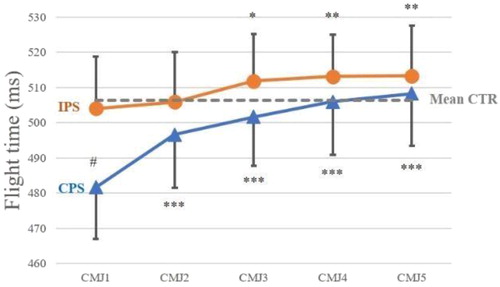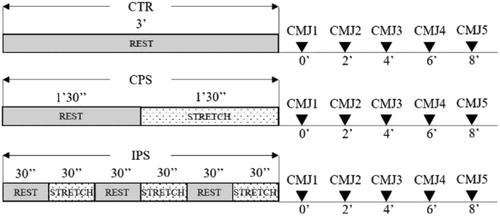1. Introduction
Warm-up is used by trainers and athletes before a range of exercises and performances. Stretch is often use to complete warm-up (Dadebo et al. Citation2004). Research has demonstrated that prolonged static stretching reduces the ability of muscle to generate power and decreases performance (Behm and Chaouachi Citation2011). However, Bogdanis et al. (Citation2017) showed intermittent stretching can improve performance on a single leg compared to the other one.
Thus, the purpose of this study is to analyse the modality of the stretch on repeated jump performance and its duration effect.
2. Methods
All data are presented as mean (SD). In total, 16 healthy participants were volunteers for this study (age: 20.9 (1.7) years, height: 178.1 (5.2) cm and body mass: 70.1 (2.8) kg). The study protocol has been explained to the subject before they gave their written informed consent. Each experimental session began with a standardized aerobic warm-up including 5 min of jogging. Protocol consisted of three conditions: control (CTR), continuous passive stretching (CPS) and intermittent passive stretching (IPS) ().
Conditions were randomly chosen for each subject in order to balance the test. Stretch was done on the quadriceps and was conducted by the same physical trainer to avoid the experimenter effect. Participants performed each countermovement jump (CMJ) with hands on their hips, starting from a static standing position and with their legs straight during the flight phase. Participants were instructed to jump as high as possible.
Jump flight time was determined using an application (My Jump 2), installed on an iPhone SE, which includes a 120 Hz high-speed camera, at a quality of 720 pixels. Flight time was recorded to analyse between two frames selected by the user.
Assumptions of normality were verified using the Shapiro-Wilk W Test. The change in CMJ performance from CTR was compared between CPS and IPS condition using a two-way repeated measures ANOVA with Fisher LSD post-hoc test. All statistical analyses were performed with Statistica software (version 10; Statsoft, Inc., Paris, France). Statistical significance was set at p < 0.05.
3. Results and discussion
Flight time is not significantly different between CMJ in CTR (p > 0.05). Consequently, we used this condition as a baseline value to evaluate the evolution of the flight time on the different conditions (CPS and IPS).
Our study showed a significant decrease of the flight time on CMJ1 during CPS condition compared to CTR (p < 0.05) and could be explained by the viscoelastic stress relaxation during the stretch (Magnusson et al. Citation1996). However, there is no significant modification during IPS condition. This can be explained by the production of an identic effect and an absolute resistance remained unaffected by stretch duration (Magnusson et al. Citation2000). This suggests that duration of stretch influences viscoelastic stress when it is greater than 30 seconds and is applied continuously.
Complementary, our study shows a significant increase of flight time on CMJ3-4-5 during IPS condition compared to the CMJ1 (). When stretch duration was shorter than 45 secs, viscoelastic stress relaxation recovered rapidly in each 30 sec of rest time between the stretch (Magnusson et al. Citation2000). Thus, the combination of short stretch with rest interval time maintain muscle stiffness. As suggested by Morse et al. (Citation2008), IPS condition maintains muscle’s thixotropic properties and limits the reduction in the muscle-tendon unit stiffness induced by the stretch. Moreover, our study is related to Bogdanis et al. (Citation2017) who found an increase in performance 4 minutes after intermittent stretch.
Figure 2. *p < 0.05; **p < 0.01; ***p < 0.001 compared to the CMJ1 on the same condition; #p < 0.05 compared to the mean CTR on the same CMJ.

Our data showed that in CPS condition, flight time is decreased just after passive stretch and tend to baseline values within 8 minutes. As suggested by Magnusson et al. (Citation1996), long duration stretch declines stiffness, energy and torque. However, on their study, biomechanical variable returns to baseline values within 1 hour. This difference with our study is due to the duration and the series of the consecutive static stretch (1 × 90’’vs. 5 × 90’’) and could explain results differences.
In addition, CMJ solicitates IIb muscle fibers to produce rapid force. Guissard et al. (Citation2001) showed during large amplitude stretching, inhibitory afferents from the Golgi tendon organs could play a role in decreased of motoneuron excitability via IIb fibers. Golgi tendon organs responds mainly to the muscle fiber contraction force and is sensitive to the mechanical tension of passive and large amplitude stretch (Houk et al. Citation1980). Thus, the duration of the stretch could decrease the flight time.
Additionally, force-velocity ratio represents a specific capacity of the muscle to produce power (). To develop a high force, the length of the sarcomere has an important role during the contraction. Balle et al. (Citation2015) showed that stretch induced strength decrements are more prevalent among athletes with short muscle length. Viscoelastic deformation of muscle components may influence force transmission and force and power production (Magnusson et al. Citation1996).
4. Conclusions
The present study examined the influence of continuous and intermittent static stretch on several CMJ performance. During continuous stretch, the decrease of flight time is due to the reduction of stiffness, energy and torque on lower limb. Duration of the stretch influence viscoelastic stress and could increase performance when it is lower than 30 seconds.
A same total stretch duration with different modality, continuous vs. intermittent modifies the performance. Thus, continuous stretch should be avoided after a warm-up performed prior to explosive muscle activities. Though, intermittent stretch could increase explosive muscle performance 4 minutes after its application.
References
- Balle SS, Magnusson SP, McHugh MP. 2015. Effects of contract-relax vs static stretching on stretchinduced strength loss and length-tension relationship. Scand J Med Sci Sports. 25(6):764–769.
- Behm DG, Chaouachi A. 2011. A review of the acute effects of static and dynamic stretching on performance. Eur J Appl Physiol. 111(11):2633–2651.
- Bogdanis GC, Donti O, Tsolakis C, Smilios I, Bishop DJ. 2017. Intermittent but not continuous static stretching improves subsequent vertical jump performance in flexibility-trained athletes. J Strength Condit Res. 33(1):203–210.
- Dadebo B, White J, George KP. 2004. A survey of flexibility training protocols and hamstring strains in professional football clubs in England. Br J Sports Med. 38(4):388–394.
- Guissard N, Duchateau J, Hainaut K. 2001. Mechanisms of decreased motoneurone excitation during passive muscle stretching. Exp Brain Res. 137(2):163–169.
- Houk JC, Crago PE, Rymer WZ. 1980. Functional properties of the Golgi tendon organs. In: Desmedt JE, editor. Progress in clinical neurophysiology, vol. 8. Basel: Karger; p. 33–43.
- Magnusson SP, Aagaard P, Nielson JJ. 2000. Passive energy return after repeated stretches of the hamstring muscle-tendon unit. Med Sci Sports Exerc. 32(6):1160–1164.
- Magnusson SP, Simonsen EB, Aagaard P, Kjaer M. 1996. Biomechanical responses to repeated stretches in human hamstring muscle in vivo. Am J Sports Med. 24(5):622–628.
- Morse CI, Degens H, Seynnes OR, Maganaris CN, Jones DA. 2008. The acute effect of stretching on the passive stiffness of the human gastrocnemius muscle tendon unit. J Physiol. 586(1):97–106.

